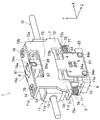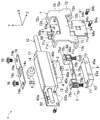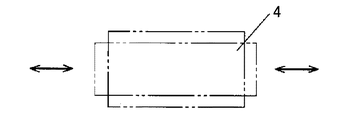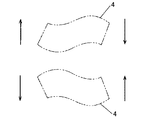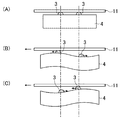JP2012055152A - Drive unit - Google Patents
Drive unit Download PDFInfo
- Publication number
- JP2012055152A JP2012055152A JP2011136051A JP2011136051A JP2012055152A JP 2012055152 A JP2012055152 A JP 2012055152A JP 2011136051 A JP2011136051 A JP 2011136051A JP 2011136051 A JP2011136051 A JP 2011136051A JP 2012055152 A JP2012055152 A JP 2012055152A
- Authority
- JP
- Japan
- Prior art keywords
- actuator
- moving body
- roller
- moving
- sliding plate
- Prior art date
- Legal status (The legal status is an assumption and is not a legal conclusion. Google has not performed a legal analysis and makes no representation as to the accuracy of the status listed.)
- Granted
Links
Images
Classifications
-
- F—MECHANICAL ENGINEERING; LIGHTING; HEATING; WEAPONS; BLASTING
- F16—ENGINEERING ELEMENTS AND UNITS; GENERAL MEASURES FOR PRODUCING AND MAINTAINING EFFECTIVE FUNCTIONING OF MACHINES OR INSTALLATIONS; THERMAL INSULATION IN GENERAL
- F16H—GEARING
- F16H19/00—Gearings comprising essentially only toothed gears or friction members and not capable of conveying indefinitely-continuing rotary motion
- F16H19/02—Gearings comprising essentially only toothed gears or friction members and not capable of conveying indefinitely-continuing rotary motion for interconverting rotary or oscillating motion and reciprocating motion
- F16H19/025—Gearings comprising essentially only toothed gears or friction members and not capable of conveying indefinitely-continuing rotary motion for interconverting rotary or oscillating motion and reciprocating motion comprising a friction shaft
-
- H—ELECTRICITY
- H02—GENERATION; CONVERSION OR DISTRIBUTION OF ELECTRIC POWER
- H02N—ELECTRIC MACHINES NOT OTHERWISE PROVIDED FOR
- H02N2/00—Electric machines in general using piezoelectric effect, electrostriction or magnetostriction
- H02N2/0005—Electric machines in general using piezoelectric effect, electrostriction or magnetostriction producing non-specific motion; Details common to machines covered by H02N2/02 - H02N2/16
- H02N2/001—Driving devices, e.g. vibrators
- H02N2/003—Driving devices, e.g. vibrators using longitudinal or radial modes combined with bending modes
- H02N2/004—Rectangular vibrators
-
- H—ELECTRICITY
- H02—GENERATION; CONVERSION OR DISTRIBUTION OF ELECTRIC POWER
- H02N—ELECTRIC MACHINES NOT OTHERWISE PROVIDED FOR
- H02N2/00—Electric machines in general using piezoelectric effect, electrostriction or magnetostriction
- H02N2/0005—Electric machines in general using piezoelectric effect, electrostriction or magnetostriction producing non-specific motion; Details common to machines covered by H02N2/02 - H02N2/16
- H02N2/005—Mechanical details, e.g. housings
- H02N2/0055—Supports for driving or driven bodies; Means for pressing driving body against driven body
-
- H—ELECTRICITY
- H02—GENERATION; CONVERSION OR DISTRIBUTION OF ELECTRIC POWER
- H02N—ELECTRIC MACHINES NOT OTHERWISE PROVIDED FOR
- H02N2/00—Electric machines in general using piezoelectric effect, electrostriction or magnetostriction
- H02N2/02—Electric machines in general using piezoelectric effect, electrostriction or magnetostriction producing linear motion, e.g. actuators; Linear positioners ; Linear motors
- H02N2/026—Electric machines in general using piezoelectric effect, electrostriction or magnetostriction producing linear motion, e.g. actuators; Linear positioners ; Linear motors by pressing one or more vibrators against the driven body
-
- H—ELECTRICITY
- H10—SEMICONDUCTOR DEVICES; ELECTRIC SOLID-STATE DEVICES NOT OTHERWISE PROVIDED FOR
- H10N—ELECTRIC SOLID-STATE DEVICES NOT OTHERWISE PROVIDED FOR
- H10N30/00—Piezoelectric or electrostrictive devices
- H10N30/20—Piezoelectric or electrostrictive devices with electrical input and mechanical output, e.g. functioning as actuators or vibrators
- H10N30/202—Piezoelectric or electrostrictive devices with electrical input and mechanical output, e.g. functioning as actuators or vibrators using longitudinal or thickness displacement combined with bending, shear or torsion displacement
- H10N30/2023—Piezoelectric or electrostrictive devices with electrical input and mechanical output, e.g. functioning as actuators or vibrators using longitudinal or thickness displacement combined with bending, shear or torsion displacement having polygonal or rectangular shape
-
- H—ELECTRICITY
- H10—SEMICONDUCTOR DEVICES; ELECTRIC SOLID-STATE DEVICES NOT OTHERWISE PROVIDED FOR
- H10N—ELECTRIC SOLID-STATE DEVICES NOT OTHERWISE PROVIDED FOR
- H10N30/00—Piezoelectric or electrostrictive devices
- H10N30/50—Piezoelectric or electrostrictive devices having a stacked or multilayer structure
-
- Y—GENERAL TAGGING OF NEW TECHNOLOGICAL DEVELOPMENTS; GENERAL TAGGING OF CROSS-SECTIONAL TECHNOLOGIES SPANNING OVER SEVERAL SECTIONS OF THE IPC; TECHNICAL SUBJECTS COVERED BY FORMER USPC CROSS-REFERENCE ART COLLECTIONS [XRACs] AND DIGESTS
- Y10—TECHNICAL SUBJECTS COVERED BY FORMER USPC
- Y10T—TECHNICAL SUBJECTS COVERED BY FORMER US CLASSIFICATION
- Y10T74/00—Machine element or mechanism
- Y10T74/18—Mechanical movements
- Y10T74/18568—Reciprocating or oscillating to or from alternating rotary
Landscapes
- Engineering & Computer Science (AREA)
- General Engineering & Computer Science (AREA)
- Mechanical Engineering (AREA)
- General Electrical Machinery Utilizing Piezoelectricity, Electrostriction Or Magnetostriction (AREA)
Abstract
【課題】移動体が正常に動作可能な移動ストロークを広げる。
【解決手段】駆動装置1は、振動することによって駆動力を出力するアクチュエータ本体4と、アクチュエータ本体4が当接しており、アクチュエータ本体4に対して所定の移動方向に相対的に移動可能な移動体11と、移動体11を挟んでアクチュエータ本体4と対向する位置に配置され、4アクチュエータ本体と共に移動体11を挟持するローラ6とを備えている。移動体11のうち、ローラ6と当接する部分は、ローラ6よりも弾性係数が小さい。
【選択図】図1An object of the present invention is to extend a moving stroke in which a moving body can operate normally.
A drive device 1 has an actuator body 4 that outputs a driving force by vibration, and the actuator body 4 is in contact with the actuator body 4 so that the actuator body 4 can move relatively in a predetermined movement direction. A body 11 and a roller 6 that is disposed at a position facing the actuator body 4 across the moving body 11 and sandwiches the moving body 11 together with the 4 actuator body. A portion of the moving body 11 that contacts the roller 6 has a smaller elastic coefficient than the roller 6.
[Selection] Figure 1
Description
ここに開示された技術は、移動体を振動型アクチュエータで駆動する駆動装置に関するものである。 The technology disclosed herein relates to a drive device that drives a moving body with a vibration actuator.
振動型アクチュエータを用いた駆動装置は従来より知られている。例えば、特許文献1に係る駆動装置は、圧電素子で構成された振動型アクチュエータを振動させることによって、移動体を駆動している。詳しくは、該駆動装置は、移動体を振動型アクチュエータと、該振動型アクチュエータに対向する対向部材とで挟み込んでいる。これら振動型アクチュエータと対向部材とは、互いに、移動体を押圧する方向に付勢されている。これにより、振動型アクチュエータと移動体との間の摩擦力を高めている。この状態で振動型アクチュエータを振動させると、その振動に伴って駆動子が変位し、移動体が駆動される。
A drive device using a vibration type actuator has been conventionally known. For example, the driving device according to
ここで、振動型アクチュエータの駆動力を移動体へ効率良く伝えるためには、振動型アクチュエータの付勢力を高めて、振動型アクチュエータと移動体との間の摩擦力を大きくする必要がある。しかし、その付勢力が大きすぎると、移動体を変形させてしまう虞がある。このため、特許文献1に係る駆動装置では、移動体の剛性を高くしている。具体的には、移動体を構成する部材を、樹脂材料やアルミニウム合金ではなく、それらよりも剛性の高いセラミックスやステンレス材料で構成している。
Here, in order to efficiently transmit the driving force of the vibration type actuator to the moving body, it is necessary to increase the biasing force of the vibration type actuator and increase the frictional force between the vibration type actuator and the moving body. However, if the urging force is too large, the moving body may be deformed. For this reason, in the drive device according to
ところで、前述の構成では、移動体の移動に伴って、移動体における、振動型アクチュエータと対向部材とが当接する部分も変化する。例えば、移動体の移動状況によっては、振動型アクチュエータと対向部材とは、移動体の端部を挟持する場合がある。しかしながら、振動型アクチュエータと対向部材とが移動体の端部を挟持する際には、移動体の駆動が不安定になるという問題がある。その結果、振動型アクチュエータと対向部材とが移動体のうち、端部以外の部分(中間部ともいう)を挟持する範囲でしか、移動体を移動させることができない。つまり、移動体の移動ストロークが制限され、大きくできない。 By the way, in the above-described configuration, as the moving body moves, the portion of the moving body where the vibration actuator and the opposing member abut also changes. For example, depending on the moving state of the moving body, the vibration type actuator and the opposing member may pinch the end of the moving body. However, when the vibration actuator and the opposing member sandwich the end of the moving body, there is a problem that the driving of the moving body becomes unstable. As a result, the movable body can be moved only within a range in which the vibration type actuator and the opposing member sandwich a portion (also referred to as an intermediate portion) other than the end portion of the movable body. That is, the moving stroke of the moving body is limited and cannot be increased.
ここに開示された技術は、かかる点に鑑みてなされたものであり、その目的とするところは、移動体が正常に動作可能な移動ストロークを広げることにある。 The technology disclosed herein has been made in view of such a point, and an object thereof is to widen a moving stroke in which the moving body can operate normally.
本願出願人は、鋭意研究の結果、移動体の端部において移動体の駆動が不安定になる原因は、移動体に作用する不要な力であることを見出した。その力について、以下に説明する。 As a result of intensive studies, the applicant of the present application has found that the cause of unstable driving of the moving body at the end of the moving body is an unnecessary force acting on the moving body. The force will be described below.
移動体は、振動型アクチュエータ及び対向部材に押圧されることによって、これらが当接する部分が凹むように変形する。一方、移動体の移動方向において、当該当接部分の両側の部分であって、当接部分から少し離れた部分は殆ど変形していない。つまり、当接部分が最も凹み、当接部分から移動方向へ離れるにつれて凹み量が小さくなっていく。こうして、移動体は、移動方向において、当接部分を中心として実質的に対称に変形している。このとき、振動型アクチュエータ及び対向部材からの押圧力は、移動体を移動方向へ移動させる力としては作用しない。 When the moving body is pressed by the vibration type actuator and the opposing member, the moving body is deformed so that a portion where the moving body abuts is recessed. On the other hand, in the moving direction of the moving body, the portions on both sides of the contact portion that are slightly apart from the contact portion are hardly deformed. That is, the contact portion is most recessed, and the amount of the recess decreases as the contact portion moves away from the contact portion. Thus, the moving body is deformed substantially symmetrically about the contact portion in the moving direction. At this time, the pressing force from the vibration type actuator and the opposing member does not act as a force for moving the moving body in the moving direction.
しかし、移動体がこのように変形するのは、当接部分が移動体の中間部に位置するときであって、当接部分が移動体の端部に位置する場合には、移動体の変形態様が異なる。当接部分が移動体の中間部に位置するときには、移動方向において、当接部分の両側には殆ど変形していない部分が存在し且つ、移動体11は連続的に繋がった構造体であるため、各部分は互いに拘束し合い、当接部分から離れるに従って変形量が小さくなっていく。
However, the moving body is deformed in this way when the abutting portion is located at the intermediate portion of the moving body, and when the abutting portion is located at the end of the moving body, the moving body is deformed. Different aspects. When the abutting portion is located at the intermediate portion of the moving body, there are portions that are hardly deformed on both sides of the abutting portion in the moving direction, and the moving
ところが、当接部分が移動体の端部に位置するときには、当接部分よりも移動方向における移動体の端側には、移動体11が少ししか存在しない。そのため、当接部分よりも移動体の端側には、変形を拘束し合う部分が少なく、移動体の端部は移動体の中間部に比べて変形しやすくなっている。換言すれば、移動体の端部は、中間部に比べて剛性が小さくなっている。ただし、移動方向において、当接部分よりも移動体の中央側には殆ど変形していない部分が存在するため、当接部分が移動体の中間部に位置するときと同様に、当接部分から離れるに従って変形量が小さくなっていく。このように、当接部分が移動体の端部に位置するときには、移動体は、移動方向において、当接部分を中心として実質的に非対称に変形している。そのため、当接部分は、移動方向に平行ではなく、移動体の端側へ向かって沈み込むように傾斜した状態となっている。その結果、振動型アクチュエータ及び対向部材からの押圧力は、移動体を移動方向へ移動させる力として作用し、移動体が振動型アクチュエータと対向部材との間から抜け出してしまう虞がある。本明細書では、この押圧力のうち、移動方向へ移動させる力として移動体へ作用する力を、「抜出力」と称する。
However, when the abutting portion is located at the end of the moving body, there is little moving
ここに開示された駆動装置は、抜出力を抑制することができる。詳しくは、前記駆動装置は、振動することによって駆動力を出力するアクチュエータ本体と、前記アクチュエータ本体が当接しており、該アクチュエータ本体に対して所定の移動方向に相対的に移動可能な移動体と、前記移動体を挟んで前記アクチュエータ本体と対向する位置に配置され、該アクチュエータ本体と共に該移動体を挟持する対向部材とを備え、前記移動体のうち、前記対向部材と当接する部分は、該対向部材よりも弾性係数が小さいものとする。 The drive device disclosed here can suppress the unplugging output. Specifically, the driving device includes an actuator main body that outputs a driving force by vibration, and a moving body that is in contact with the actuator main body and is movable relative to the actuator main body in a predetermined movement direction. And a counter member that sandwiches the moving body together with the actuator body, and a portion of the moving body that contacts the counter member is It is assumed that the elastic coefficient is smaller than that of the opposing member.
前記駆動装置によれば、前記移動体のうち前記対向部材と当接する部分は、該対向部材よりも弾性係数が小さいため、移動体が対向部材からの押圧力により変形するときには、対向部材が当接している部分が局所的に変形する。それにより、当接部分の傾斜を抑制することができるため、抜出力を低減することができる。その結果、移動体が正常に動作可能な移動ストロークを広げることができる。 According to the drive device, the portion of the moving body that contacts the opposing member has an elastic coefficient smaller than that of the opposing member. Therefore, when the moving body is deformed by the pressing force from the opposing member, the opposing member is in contact. The contacting part is locally deformed. Thereby, since the inclination of the contact portion can be suppressed, the unplugging power can be reduced. As a result, it is possible to widen the moving stroke in which the moving body can operate normally.
以下、本発明の実施形態を図面に基づいて詳細に説明する。 Hereinafter, embodiments of the present invention will be described in detail with reference to the drawings.
図1は、実施形態に係る駆動装置の斜視図を、図2は、駆動装置を図1とは別の角度から観た斜視図を、図3は、駆動装置の分解斜視図を示す。尚、図中のX軸は、後述する移動体11の移動方向と一致し、Y軸は、後述するアクチュエータ本体4及びローラ6の付勢方向と一致し、Z軸は、該移動方向及び付勢方向の両方に直交する方向と一致する。図10〜14においても同様である。実施形態に係る駆動装置1は、図1〜3に示すように、基台(図示省略)に固定されたシャフト10と、該シャフト10に摺動自在に設けられた移動体11と、該移動体11を駆動する超音波アクチュエータ2と、該基台に対して固定され、該超音波アクチュエータ2を支持する支持体8と、該超音波アクチュエータ2を駆動制御する制御装置(図示省略)とを備えている。
FIG. 1 is a perspective view of the drive device according to the embodiment, FIG. 2 is a perspective view of the drive device viewed from a different angle from FIG. 1, and FIG. 3 is an exploded perspective view of the drive device. In the figure, the X axis coincides with the moving direction of the moving
移動体11は、四角柱状であって、その軸方向に貫通孔11b(図10にのみ図示)が貫通形成された移動体本体11aと、貫通孔11bの両端部に設けられた軸受部15(図1〜3では、それぞれ1つだけ図示)と、後述するアクチュエータ本体4が当接する第1摺動板13と、後述するローラ6が当接する第2摺動板14とを有している。軸受部15は、貫通孔11bに圧入又は接着固定されている。この軸受部15に、シャフト10が挿通される。こうして、移動体11は、シャフト10の軸方向(図中のX軸方向)に沿って摺動可能に構成されている。このシャフト10の延びる方向が移動体11の可動方向となる。この移動体11は、詳しくは後述するが、超音波アクチュエータ2が発生する駆動力を受けて、シャフト10に沿って移動する。
The
ここで、移動体本体11aは、例えば、ガラス繊維を含有するポリカーボネートで構成されている。ガラス繊維は、ポリカーボネートの剛性を高めるために添加されている。一般的な、ガラス繊維を含有するポリカーボネートのヤング率は、3.4〜8.8GPaである。また、軸受部15は、例えば、摺動性に優れた含油軸受である。軸受部15は、例えば、焼結により製造される。軸受部15のヤング率は、例えば、約54GPaである。すなわち、軸受部15は、移動体本体11aよりもヤング率、即ち、弾性係数が大きい。
Here, the
第1摺動板13は、例えば、アルミナで構成され、移動体本体11aの4つの側面のうちの一の側面(図1〜3では下面)に接着固定されている。アルミナのヤング率は、概ね250〜400GPaである。第1摺動板13の剛性は、移動体本体11aよりも高くなっている。また、第1摺動板13の厚み(Y軸方向の寸法)は、第2摺動板14の2倍以上の厚さとなっている。こうして、第1摺動板13の曲げ剛性を高くし、移動体本体11aの変形を小さくしている。この第1摺動板13が摺動部材を構成する。
The first sliding
一方、第2摺動板14は、例えば、プラスチック材料で構成され、移動体本体11aの4つの側面のうち、第1摺動板13が設けられた側面と対向する側面に接着固定されている。プラスチック材料の例としては、ガラス繊維を含まないポリカーボネートが挙げられる。ポリカーボネートのヤング率は、約2.6GPaである。すなわち、第2摺動板14の弾性係数は、移動体本体11aの弾性係数よりも小さい。また、第2摺動板14の弾性係数は、後述するローラ6の弾性係数よりも小さい。
On the other hand, the second sliding
尚、第1及び第2摺動板13,14の材質も前述の材質に限られるものではなく、任意の材質を用いて形成することができる。ただし、第2摺動板14の弾性係数は、ローラ6の弾性係数よりも小さくすることが好ましく、移動体本体11aの弾性係数よりも小さくすることがさらに好ましい。
In addition, the material of the first and second sliding
以下に、超音波アクチュエータ2の構成について説明する。超音波アクチュエータ2は、移動体11に当接するように付勢されると共に振動することにより移動体11に駆動力を出力するアクチュエータ本体4と、該アクチュエータ本体4を保持するホルダ5と、アクチュエータ本体4と共に移動体11を挟持するローラ6と、アクチュエータ本体4とローラ6とを弾性的に連結する連結部材7とを備えている。この超音波アクチュエータ2が振動型アクチュエータを構成する。
Below, the structure of the
前記アクチュエータ本体4は、圧電素子で構成されている。アクチュエータ本体4は、略長方形状の相対向する一対の主面40a(図3では1つだけ図示)と、この主面40aと直交して該主面40aの長手方向に延びる、相対向する一対の長辺側面40c(図3では1つだけ図示)と、これら主面40a及び長辺側面40cの両方と直交して該主面40aの短手方向に延びる、相対向する一対の短辺側面40e(図3では1つだけ図示)とを有する略直方体状をしている。アクチュエータ本体4には、該アクチュエータ本体4の駆動力を移動体11に伝達する駆動子3,3が設けられている。
The
図4に、アクチュエータ本体4の分解斜視図を示す。アクチュエータ本体4は、図4に示すように、圧電体層(圧電素子)41,41,…と内部電極層42,44,43,44とを交互に積層して構成される。内部電極層42,44,43,44は、積層方向に圧電体層41を介して交互に配された、第1給電電極層42と共通電極層44と第2給電電極層43と共通電極層44とを含んでいる。これら第1給電電極層42と共通電極層44と第2給電電極層43と共通電極層44とを1セットとして、複数セットの内部電極層42,44,43,44が圧電体層41を介在させた状態で繰り返し積層されている。尚、積層方向の両端には、圧電体層41,41が位置するようになっている。これら第1給電電極層42、第2給電電極層43及び共通電極層44のそれぞれは、各圧電体層41の主面上に印刷されている。
FIG. 4 shows an exploded perspective view of the
前記各圧電体層41は、例えばチタン酸ジルコン酸鉛などのセラミック材料からなる絶縁体層である。圧電体層41は、前記アクチュエータ本体4と同様に、一対の主面と、一対の長辺側面と、一対の短辺側面とを有する略直方体状をしている。また、各圧電体層41のそれぞれの長辺側面には、長手方向両端部に第1及び第2外部電極46,47が形成され、該第1及び第2外部電極46,47よりも長手方向内側には2つの共通外部電極48,48が形成されている。すなわち、圧電体層41の各長辺側面には、第1外部電極46、共通外部電極48、共通外部電極48、第2外部電極47が、長手方向に沿ってこの順で、互いに間隔を空けて並んでいる。
Each
前記各共通電極層44は、圧電体層41の主面の略全面に亘って設けられた略長方形状をしている。また、各共通電極層44のそれぞれの長辺部からは、圧電体層41の長辺側面に形成された共通外部電極48,48まで延びる引出電極44a,44aが形成されている。
Each common electrode layer 44 has a substantially rectangular shape provided over substantially the entire main surface of the
前記第1及び第2給電電極層42,43は、図5に示すように、圧電体層41の主面をその長手方向及び短手方向にそれぞれ2等分してなる4つの領域のうち該主面の対角線方向に位置する2対の領域のうち一方の対の領域にそれぞれ形成された一対の第1電極42a,42bと、他方の対の領域にそれぞれ形成された一対の第2電極43a,43bとを有する。これら第1電極42a,42b及び第2電極43a,43bは、圧電体層41を挟んで共通電極層44と対向している。また、第1電極42a,42bのそれぞれからは、それらに近接する、圧電体層41の長辺側面に形成された第1外部電極46,46まで延びる引出電極42d,42dが形成されている。第2電極43a,43bのそれぞれからは、それらに近接する、圧電体層41の長辺側面に形成された第2外部電極47,47まで延びる引出電極43d,43dが形成されている。そして、第1給電電極層42においては、第1電極42a,42bが第1導通電極42cを介して導通している。また、第2給電電極層43においては、第2電極43a,43bが第2導通電極43cを介して導通している。
As shown in FIG. 5, the first and second
これら圧電体層41,41,…と内部電極層42,44,43,44とを交互に積層することで構成されたアクチュエータ本体4の各長辺側面40c,40dにおいては、各圧電体層41の共通外部電極48,48がそれぞれ積層方向に並んで一まとまりに形成されている。この外部電極48には、前記共通電極層44,44に形成された引出電極44a,44aが電気的に接続されている。こうして、異なる圧電体層41,41,…に設けられた共通電極層44,44,…は、共通外部電極48,48を介して互いに導通している。
The
同様に、アクチュエータ本体4の各長辺側面40c,40dにおいては、各圧電体層41の第1外部電極46が積層方向に並んで一まとまりに形成されていると共に、各圧電体層41の第2外部電極47が積層方向に並んで一まとまりに形成されている。第1外部電極46,46には、前記第1電極42a,42bからの引出電極42d,42dが電気的に接続されている。また、第2外部電極47,47には、前記第2電極43a,43bからの引出電極43d,43dが電気的に接続されている。こうして、第1電極42a,42bは、第1導通電極42c及び第1外部電極46,46を介して、異なる圧電体層41,41,…に設けられた第1電極42a,42bと互いに導通している。また、第2電極43a,43bは、第2導通電極43c及び第2外部電極47,47を介して、異なる圧電体層41,41,…に設けられた第2電極43a,43bと互いに導通している。これら外部電極46,47,48には、制御装置からの信号線が接続される。アクチュエータ本体4は、外部電極46,47,48を介して給電される。
Similarly, on each of the long side surfaces 40c and 40d of the
そして、アクチュエータ本体4の一方の長辺側面(すなわち、後述する屈曲振動の振動方向を向く一対の面のうちの一方の面。以下、設置面ともいう)40cには、2個の駆動子3,3が設けられている。
In addition, one long side surface of the actuator body 4 (that is, one surface of a pair of surfaces facing a vibration direction of bending vibration described later, hereinafter also referred to as an installation surface) 40c includes two
これら駆動子3,3は、断面半円形の柱状の部材であって、ジルコニア、アルミナ、窒化ケイ素、炭化ケイ素、タングステンカーバイド等で形成されている。駆動子3,3は、その軸方向がアクチュエータ本体4の厚み方向を向くように配設されている。駆動子3,3は、設置面40cに対して接着剤を介して面接触状に取り付けられている。
These
また、駆動子3,3が設けられた位置は、設置面40cにおいて、アクチュエータ本体4の長手方向両端部から該設置面40cの全長の30〜35%距離だけ内側に入った位置であり、即ち、アクチュエータ本体4の後述する屈曲振動の2次モードの腹の位置であって、振動が最も大きくなる位置である。
Further, the positions where the driving
このように構成されたアクチュエータ本体4は、前記外部電極48をグランドに接続し、前記第1及び第2外部電極46,47に所定周波数の交流電圧を位相が90°ずれた状態で印加することによって、圧電体層41の主面の対角線方向に位置する一方の対の第1電極42a,42bと、他方の対の第2電極43a,43bとに互いに位相が90°ずれた交流電圧が印加され、その長手方向への伸縮振動(いわゆる、縦振動)とその短手方向への屈曲振動(いわゆる、横振動)とが誘起される。
The
伸縮振動の共振周波数及び屈曲振動の共振周波数は、アクチュエータ本体4の材料、形状等により決定される。さらに、両共振周波数は、アクチュエータ本体4を支持する力及び支持する部分によっても影響を受ける。これらを考慮して両共振周波数を略一致させ、その近傍の周波数の交流電圧を、位相を90°ずらした状態で第1及び第2外部電極46,47のそれぞれに印加する。例えば、伸縮振動の1次モード(図6参照)の共振周波数と屈曲振動の2次モード(図7参照)の共振周波数とが一致するようにアクチュエータ本体4の形状等を設計して、該共振周波数近傍の交流電圧を前述の如く、位相を90°ずらして印加することによって、アクチュエータ本体4には、伸縮振動の1次モードと屈曲振動の2次モードとが調和的に誘起され、図8(A)、(B)、(C)、(D)に示す形状の変化を順番に起こす。
The resonance frequency of the stretching vibration and the resonance frequency of the bending vibration are determined by the material, shape, and the like of the
その結果、アクチュエータ本体4に設けられた各駆動子3が該アクチュエータ本体4の主面と平行な平面(図7における紙面と平行な面)、即ち、長手方向と短手方向とを含む平面(さらに換言すれば、伸縮振動の振動方向と屈曲振動の振動方向とを含む平面)内で略楕円運動、即ち、周回運動を行う。
As a result, each
このように構成されたアクチュエータ本体4は、駆動子3,3が移動体11の第1摺動板13に当接する状態で配設される。
The
ホルダ5は、ポリカーボネート(ガラス繊維入り)で構成された、四角柱状の部材である。ホルダ5は、アクチュエータ本体4の駆動子3,3が設けられていない方の長辺側面に設けられている。ホルダ5は、アクチュエータ本体4の長手方向中央において厚み方向(即ち、積層方向)に延びるようにして、該長辺側面に、例えば接着剤を介して取り付けられている。ホルダ5の両端部は、アクチュエータ本体4の両主面から厚み方向に突き出ている。
The
ローラ6は、ローラ本体61と、ローラシャフト62とを有している。ローラ本体61は、ボールベアリングを介してローラシャフト62に回転自在に取り付けられている。このローラ6が、対向部材を構成する。このローラ6は、移動体11に当接すると共に該移動体11を挟んでアクチュエータ本体4と対向する位置に位置する。ローラ本体61及びローラシャフト62は、剛性を高めるためにSUS304やSUS410といったステンレス合金で形成されている。ステンレス合金のヤング率は、約200GPaである。
The
連結部材7は、連結部材本体70と、該連結部材本体70に取り付けられてローラ6を移動体11に押圧するための押圧板74と、該連結部材本体70に取り付けられてアクチュエータ本体4を移動体11に押圧するための板バネ75とを有している。連結部材7は、アクチュエータ本体4とローラ6とを連結すると共に、該アクチュエータ本体4とローラ6とが移動体11を押圧するように該アクチュエータ本体4とローラ6とを付勢している。
The connecting
連結部材本体70は、アクチュエータ本体4の短手方向に互いに平行に延びる第1連結部71及び第2連結部72と、アクチュエータ本体4の長手方向に延びて該第1及び第2連結部71,72を連結する第3連結部73とを有している。
The connecting
第1連結部71は、アクチュエータ本体4の短手方向へ平坦に延びる本体部71aと、該本体部71aの両端部から本体部71aに対して略垂直に屈曲する取付部71b,71bとを有している。第2連結部72は、第1連結部71と同様の形状をしており、本体部72aと、取付部72b,72bとを有している。取付部71b,72bには、それぞれネジ孔71c,72c(図3にのみ図示)が貫通形成されている。第1連結部71の一方の取付部71b及び第2連結部72の一方の取付部72bは、移動体11の第2摺動板14と対向し、第1連結部71の他方の取付部71b及び第2連結部72の他方の取付部72bは、移動体11の第1摺動板13と対向する。第3連結部73は、第1連結部71の本体部71aと、第2連結部72の本体部72aとを連結している。第3連結部73は、第1連結部71の本体部71aや第2連結部72の本体部72aと同一平面上を延びるのではなく、本体部71a及び本体部72aよりも取付部71b,72bとは反対側に浮き上がっている。これら第1〜第3連結部71〜73は、平板を屈曲させて一体に形成されており、全体としてH字状に形成されている。
The first connecting
押圧板74は、略長方形状の平板で構成されている。押圧板74は、その長手方向中央に長方形の貫通孔74aが、長手方向両端部に円形の挿通孔74b,74b(図3にのみ図示)が貫通形成されている。押圧板74は、第1及び第2連結部71,72の、第2摺動板14と対向する側の取付部71b,72bにネジ締結される。詳しくは、押圧板74の挿通孔74b,74bに挿通されたネジ76,76がそれぞれ、取付部71bのネジ孔71c及び取付部72bのネジ孔72cに締結されることによって、押圧板74が第1及び第2連結部71,72に取り付けられる。尚、押圧板74は、第1及び第2連結部71,72と一体に構成してもよい。
The
このとき、押圧板74と移動体11とでローラ6を挟持している。詳しくは、ローラ本体61は、押圧板74の貫通孔74a内に位置し、該貫通孔74aから突出している。このとき、ローラ6のローラシャフト62は、押圧板74と接触しており、押圧板74により移動体11側へ押圧されている。その結果、ローラ本体61が移動体11の第2摺動板14に押し付けられる。尚、押圧板74の長辺における、長手方向中央には、その短手方向に突出する突起部74c,74cが設けられている。
At this time, the
板バネ75は、板金を折り曲げて構成されている。詳しくは、板バネ75は、アクチュエータ本体4の長辺側面と平行な底板部75aと、底板部75aの両端部から立設され、アクチュエータ本体4の短辺側面と平行な縦板部75b,75bと、縦板部75b,75bの先端から外側へ底板部75aと平行に延びるフランジ部75c,75cとを有している。板バネ75は、アクチュエータ本体4の、ホルダ5が設けられた長辺側面及び2つの短辺側面を外側から覆うように、全体として凹形状をしている。各フランジ部75cには、後述するネジを挿通させる挿通孔75dが貫通形成されている。
The
この板バネ75は、第1及び第2連結部71,72の、第1摺動板13と対向する側の取付部71b,72bにネジ締結される。詳しくは、板バネ75の挿通孔75d,75dに挿通された段付ネジ77,77がそれぞれ、取付部71bのネジ孔71c及び取付部72bのネジ孔72cに締結されることによって、板バネ75が第1及び第2連結部71,72に取り付けられる。このとき、段付ネジ77には、コイルバネ78が外嵌されている。このコイルバネ78は、段付ネジ77の頭と板バネ75とに挟持されて圧縮変形している。こうして連結部材7に取り付けられる板バネ75は、移動体11との間にアクチュエータ本体4を収容し、移動体11との間で該アクチュエータ本体4を挟持している。詳しくは、板バネ75の底板部75aがアクチュエータ本体4に設けられたホルダ5と当接している。その結果、圧縮変形したコイルバネ78の弾性力が板バネ75及びホルダ5を介してアクチュエータ本体4を移動体11側へ付勢する。その結果、アクチュエータ本体4は、移動体11の第1摺動板13を押圧する。すなわち、これら板バネ75、段付ネジ77及びコイルバネ78が付勢部として機能する。
The
それに加えて、コイルバネ78の弾性力は、段付ネジ77を介して連結部材7にも伝達し、さらに連結部材7及び押圧板74を介してローラ6に伝達する。つまり、コイルバネ78の弾性力は、ローラ6を移動体11側へ付勢する。その結果、ローラ6は、移動体11の第2摺動板14を押圧する。
In addition, the elastic force of the
このように、超音波アクチュエータ2では、連結部材7によって連結されたアクチュエータ本体4とローラ6とが移動体11を挟持した状態で該移動体11を押圧している。こうして、アクチュエータ本体4の駆動子3,3と移動体11との間には、コイルバネ78の弾性力に応じた摩擦力が生じている。その結果、駆動子3,3から出力される駆動力を移動体11に効率良く伝達することができる。そして、このように駆動子3,3を移動体11に押圧する構成であっても、移動体11は駆動子3,3と反対側から駆動子3,3の押圧力と同様の押圧力でローラ6により押圧されているため、移動体11に作用する押圧力は相殺される。その結果、シャフト10に、偏った不要な力が作用することを防止することができ、移動体11を円滑に移動させることができる。
As described above, in the
次に、支持体8の構成について説明する。支持体8は、アクチュエータ本体4を支持する第1及び第2支持板81,82と、第1及び第2支持板81,82が取り付けられると共に基台に固定されるベース部材83とを有している。この支持体8が支持部を構成する。
Next, the configuration of the
ベース部材83は、ブロック状の部材であって、基台にネジ締結される。また、ベース部材83には、第1及び第2支持板81,82を取り付けるためのネジ孔83a,83a(図3に2つだけ図示)が形成されている。
The
第1支持板81は、屈曲した板状の部材で構成されている。第1支持板81は、方形の基端部84と、基端部84から延びる延設部85と、延設部85の先端部に対向して設けられた対向ガイド部86と、該延設部85と対向ガイド部86とを連結する連結部87とを有している。
The
また、基端部84の中央には、開口部84aが厚み方向に貫通形成されている。この開口部84aに、ホルダ5を支持するためのガイド部材88(図3では1つだけ図示)が設けられる。ガイド部材88は、基端部84に接着固定されている。ガイド部材88には、アクチュエータ本体4を移動体11へ付勢する方向(即ち、アクチュエータ本体4の短手方向であって、図中のY軸方向)に延びる長孔状のガイド孔88aが貫通形成されている。ガイド孔88aは、ホルダ5の幅よりも少し余裕のある幅を有している。ガイド孔88aには、ホルダ5の、アクチュエータ本体4の厚み方向に突出する端部が挿入される。ホルダ5の端部は、ガイド孔88a内をガイド孔88aの延伸方向に摺動することができる。ガイド部材88は、基端部84よりも弾性率が小さく、又硬度が小さい材料で構成されている。また、ガイド部材88は、ホルダ5よりも軟質で、しかも樹脂などに対して摺動性に優れる材料で構成されている。例えば、ガイド部材88は、ポリアセタールで構成されている。尚、ホルダ5の突出量によっては、ガイド孔88aはガイド部材88を貫通せず、有底状であってもよい。また、基端部84の四隅のうち、延設部85が設けられた辺と反対側の辺の両端に位置する2つの隅部にはそれぞれ、挿通孔84bが貫通形成されている。これら挿通孔84b,84bにネジ84c,84cを挿通し、該ネジ84c,84cをベース部材83のネジ孔83a,83aに締結することによって、第1支持板81がベース部材83に取り付けられる。
In addition, an
延設部85は、基端部84の一辺から、ガイド孔88aの延設方向と同じ方向に延びている。延設部85の先端には、ガイド溝85aとなる切り込みが形成されている。すなわち、延設部85の先端は、二股状に形成されている。このガイド溝85aの延びる方向と基端部84のガイド孔88aの延びる方向とは一致している。すなわち、ガイド溝85aとガイド孔88aとは、一直線上に配置されている。
The extending
対向ガイド部86は、延設部85の先端部と同様に、ガイド溝86aとなる切り込みが形成され、二股状に形成されている。この対向ガイド部86は、延設部85の先端部と対向する状態で、連結部87を介して該先端部に連結されている。
The opposing
ガイド溝85a,86aは、ローラ6のローラシャフト62の外径よりも少し余裕のある幅を有しており、ローラシャフト62が嵌るように構成されている。また、ガイド溝85a,86aには、ローラシャフト62に加えて、押圧板74の突起部74c,74cが嵌るように構成されている。
The
また、第2支持板82は、略長方形状の平板状の部材で構成されている。第2支持板82の略中央には、開口部82aが厚み方向に貫通形成されている。この開口部82aに、ホルダ5を支持するためのガイド部材(図示省略)が設けられる。このガイド部材は、第1支持板81のガイド部材88と同じ構成をしている。すなわち、ガイド部材には、アクチュエータ本体4を移動体11へ付勢する方向に延びる長孔状のガイド孔が貫通形成されている。このガイド孔には、ホルダ5の、アクチュエータ本体4の厚み方向に突出する端部が挿入される。ホルダ5の端部は、ガイド孔内をガイド孔の延伸方向に摺動することができる。アクチュエータ本体4の短手方向に延びる略長方形のガイド孔が貫通形成されている。ガイド孔は、ホルダ5の幅よりも少し余裕のある幅を有しており、ホルダ5が嵌るように構成されている。また、第2支持板82の四隅のうち、一方の長辺の両端に位置する2つの隅部にはそれぞれ、挿通孔82b,82bが貫通形成されている。これら挿通孔82b,82bにネジ82c,82cを挿通し、該ネジ82c,82cをベース部材83のネジ孔83a,83aに締結することによって、第2支持板82がベース部材83に取り付けられる。第2支持板82をベース部材83に取り付けたとき、開口部82aに設けられたガイド部材のガイド孔は、第1支持板81の対向ガイド部86のガイド溝86aと一直線上に配置される。
The
このように、支持体8は、超音波アクチュエータ2のホルダ5を第1及び第2支持板81,82の開口部84a,82aに設けたガイド部材88のガイド孔88aで支持すると共に、超音波アクチュエータ2のローラシャフト62を第1支持板81のガイド溝85a,86aで支持する。これら第1及び第2支持板81,82がガイド部を、ガイド孔88aが長孔を、ガイド溝85a,86aが溝を構成し、ホルダ5及びローラシャフト62が係合部を構成する。
As described above, the
ここで、ホルダ5が嵌るガイド孔88aと、ローラシャフト62が嵌るガイド溝85a,86aとは、アクチュエータ本体4の厚み方向を向かって見たときに一直線上に配置されているため、ローラ6と移動体11との当接部分は、シャフト10の軸方向において、2つの駆動子3,3と移動体11との当接部の中間地点と一致している。すなわち、ローラ6及びアクチュエータ本体4で移動体11を挟み込む押圧力は、ローラ6と移動体11との当接部分を通り且つローラ6及びアクチュエータ本体4で挟み込む方向(即ち、アクチュエータ本体4の短手方向)に延びる直線に対して線対称に作用する。
Here, since the
このように構成された駆動装置1の動作は、制御装置によって制御される。詳しくは、制御装置は、外部からの動作指令を受けて、その動作指令に応じた周波数の交流電圧を動作指令に応じた位相差で第1及び第2外部電極46,47に印加する。こうして、制御装置は、アクチュエータ本体4に伸縮振動と屈曲振動とを調和的に発生させて、駆動子3,3を図8に示すように周回運動させる。このとき、駆動子3,3は、連結部材7により移動体11に付勢されており、駆動子3,3と移動体11との間には十分な摩擦力が作用している。その結果、摩擦力を介して、移動体11がシャフト10に沿って駆動される。尚、移動体11の第2摺動板14にはローラ6が駆動子3,3の摩擦力と同等の摩擦力で当接しているが、ローラ本体61はボールベアリングを介して回転するため、ローラ6が移動体11の移動を妨げることはない。
Operation | movement of the
尚、制御装置は、アクチュエータ本体4の異常発熱を防止すべく、アクチュエータ本体4の伸縮振動と屈曲振動との共通の共振周波数よりも少し高い周波数の交流電圧を第1及び第2外部電極46,47に印加する。このとき、かかる交流電圧は、互いに位相が90°ずれた状態で第1及び第2外部電極46,47に印加される。
In order to prevent abnormal heat generation of the
移動体11の駆動について、さらに詳しく説明する。駆動子3,3が略楕円運動を行うと、駆動子3,3と移動体11の第1摺動板13との間の摩擦力の増減が周期的に繰り返される。このとき、アクチュエータ本体4の長手方向への駆動力が摩擦力を介して移動体11に伝達され、移動体11はシャフト10に沿って移動する。このアクチュエータ本体4の長手方向(シャフト10が延びる方向と一致する)が、駆動子3,3が駆動力を出力する方向である駆動方向に相当する。尚、アクチュエータ本体4には、駆動力とは長手方向反対向きの反力が移動体11から作用する。しかし、アクチュエータ本体4に取り付けられたホルダ5がガイド孔88aに係合しているため、該反力は第1及び第2支持板81,82で受け止められる。そのため、アクチュエータ本体4は、駆動力を移動体11へ適切に出力することができる。
The driving of the moving
さらに詳しくは、アクチュエータ本体4が長手方向(伸縮振動の振動方向)に伸張するとき、一方(例えば、図9の左側)の駆動子3は、図9(B)に示すように、移動体11との間の摩擦力を駆動前の状態(即ち、単に設置しただけの状態)よりも増大させながら変位するため、この摩擦力によって移動体11を該長手方向における該一方の駆動子3が変位する側(図9の左側)へ移動させる。このとき、他方(図9の右側)の駆動子3は、該長手方向において一方の駆動子3とは逆向きに変位するが、該駆動子3は移動体11から離れた状態で変位するか、又は移動体11との間の摩擦力を駆動前の状態よりも減少させながら変位するため、移動体11の移動にはほとんど影響を与えない。
More specifically, when the
一方、アクチュエータ本体4が長手方向に収縮するときは、他方(図9の右側)の駆動子3は、図9(C)に示すように、移動体11との間の摩擦力を駆動前の状態(即ち、単に設置しただけの状態)よりも増大させながら変位するため、この摩擦力によって移動体11を該長手方向における該他方の駆動子3が変位する側(図9の左側)へ移動させる。この移動方向は、前述した、アクチュエータ本体4の伸張時における一方の駆動子3による移動体11の移動方向と同じである。このとき、一方(図9の左側)の駆動子3は、該長手方向において他方の駆動子3とは逆向きに変位するが、該駆動子3は移動体11から離れた状態で変位するか、又は移動体11との間の摩擦力を駆動前の状態よりも減少させながら変位するため、移動体11の移動にはほとんど影響を与えない。
On the other hand, when the
尚、図9においては、移動体11の移動に影響を与えない方の駆動子3は移動体11から離れているが、必ずしも離れている必要はない。すなわち、駆動子3は、移動体11を移動させない程度の摩擦力で該移動体11に当接している状態であってもよい。
In FIG. 9, the
こうして、一方の駆動子3と他方の駆動子3とは、位相が180°ずれた状態で交互に移動体11を所定の一方向へ移動させる。尚、前記交流電圧を、その位相を−90°ずらした状態で第1及び第2外部電極46,47に印加することによって、駆動子3,3が出力する駆動力を逆向きにすることができ、移動体11を他方向へ移動させることができる。
Thus, one
続いて、駆動装置1の組み立てについて説明する。
Next, the assembly of the
まず、押圧板74を連結部材本体70にネジ76,76で取り付ける。また、ローラ6のローラシャフト62を、第1支持板81のガイド溝85a,86aに嵌め込む。ガイド溝85a,86aの幅がローラシャフト62の外径に対してわずかに広いため、ローラシャフト62は、ガイド溝85a,86aの延びる方向へ自由に動くことができる。次に、第1支持板81をベース部材83にネジ84c,84cで固定する。そして、これら連結部材本体70及び第1支持板81を、最終的な組立時の位置関係となるように治具に固定する。このとき、押圧板74の突起部74c,74cを第1支持板81のガイド溝85a,86aに嵌め込んで、該押圧板74を連結部材本体70にネジ76,76で固定する。
First, the
続いて、アクチュエータ本体4に固定されているホルダ5の一端部を第1支持板81のガイド孔88aに挿入する。このとき、駆動子3,3がローラ6側を向くように、アクチュエータ本体4を配置する。そして、アクチュエータ本体4のホルダ5が設けられている側に板バネ75を配置する。その後、ホルダ5の他端部を第2支持板82のガイド孔に挿入し、該第2支持板82をネジ82c,82cを介してベース部材83に固定する。
Subsequently, one end of the
次に、移動体11を、第2摺動板14が駆動子3,3と対向するようにして、アクチュエータ本体4とローラ6との間に配置する。そして、コイルバネ78を外嵌した段付ネジ77を介して、板バネ75を連結部材本体70に取り付ける。このとき、コイルバネ78を圧縮変形させる。コイルバネ78の弾性力は、板バネ75を介してアクチュエータ本体4に伝達される。その結果、アクチュエータ本体4は、移動体11に向かって付勢(押圧)される。このコイルバネ78の弾性力は、アクチュエータ本体4に作用するだけでなく、反力として、連結部材本体70にも作用する。コイルバネ78の反力は、連結部材本体70を介してローラ6を移動体11に向かって付勢(押圧)する。その結果、アクチュエータ本体4とローラ6とで移動体11を挟み込んだ状態で、その挟み込む方向(即ち、アクチュエータ本体4とローラ6とが互いに接近する方向)へ該移動体11を押圧する。かかる構成により、アクチュエータ本体4と移動体11との間の摩擦力を十分に確保することができ、アクチュエータ本体4の駆動力を移動体11に効率良く伝えることができる。尚、アクチュエータ本体4及びローラ6の付勢力、即ち、アクチュエータ本体4と移動体11との間の摩擦力は、コイルバネ78の圧縮量によって調整することができる。
Next, the
このように構成された超音波アクチュエータ2は、アクチュエータ本体4及びローラ6を移動体11へ付勢する付勢方向(即ち、移動体11をアクチュエータ本体4とローラ6とで挟み込む方向であって、図中のY軸方向)に変位可能な状態で支持体8に支持されている。詳しくは、アクチュエータ本体4に取り付けられたホルダ5は、ガイド孔88a内を前記付勢方向に移動可能となっていると共に、ローラ6のローラシャフト62は、ガイド溝85a,86a内を前記付勢方向に移動可能となっている。そのため、シャフト10、移動体11、超音波アクチュエータ2及び支持体8の形状誤差及び取付誤差により超音波アクチュエータ2と移動体11との位置関係が付勢方向へずれた場合であっても、超音波アクチュエータ2が該付勢方向へ変位して該位置ずれを吸収することができる。その結果、超音波アクチュエータ2の該付勢方向への位置が自動的に調整され、アクチュエータ本体4が移動体11を押圧する力と、ローラ6が移動体11を押圧する力とのバランスがとられる。こうして、シャフト10に不要な力を作用させることなく、アクチュエータ本体4を移動体11へ押圧することができるため、アクチュエータ本体4の駆動力を移動体11へ効率良く伝達することができる。
The
さらに、ホルダ5は、第1支持板81のガイド孔88a及び第2支持板82のガイド孔に対して、シャフト10の軸方向及び連結部材7の付勢方向に直交する方向(即ち、アクチュエータ本体4の厚み方向であって、図中のZ軸方向。以下、「直交方向」という。)に変位可能に嵌っている。また、ローラシャフト62は、第1支持板81のガイド溝85a,86aに対して前記直交方向に変位可能に嵌っている。つまり、超音波アクチュエータ2は、前記直交方向に変位可能な状態で支持体8に支持されている。そのため、形状誤差及び取付誤差により超音波アクチュエータ2と移動体11との位置関係が該直交方向へずれた場合であっても、超音波アクチュエータ2が支持体8に対して直交方向へ変位することによって、該位置ずれを吸収することができる。その結果、シャフト10に不要な力を作用させることなく、アクチュエータ本体4を移動体11に押圧することができるため、アクチュエータ本体4の駆動力を移動体11へ効率良く伝達することができる。
Furthermore, the
また、アクチュエータ本体4及びローラ6は、移動体11を付勢方向に挟み込んでいるものの、該付勢方向に直交する平面内においては移動体11に対して変位可能である。そのため、アクチュエータ本体4及びローラ6が付勢方向に直交する平面内で前記直交方向に変位することによっても、超音波アクチュエータ2と移動体11との該直交方向への位置ずれを吸収することができる。
Further, although the
尚、移動体11はシャフト10の軸方向に移動可能であるため、形状誤差及び取付誤差により超音波アクチュエータ2と移動体11との位置関係が該軸方向へずれた場合であっても、該軸方向への位置ずれは、移動体11がシャフト10に沿って移動することによって吸収することができる。
Since the
さらに、ホルダ5が嵌るガイド孔88aと、ローラシャフト62が嵌るガイド溝85a,86aとは前記付勢方向に延びる長孔状に形成されているため、超音波アクチュエータ2はシャフト10の軸回りに回転することができる。そのため、形状誤差及び取付誤差により超音波アクチュエータ2と移動体11との位置関係が該軸回りの回転方向へずれた場合であっても、超音波アクチュエータ2が支持体8に対して該軸回りに回転することによって、該位置ずれを吸収することができる。
Further, since the
さらにまた、ガイド孔88aはホルダ5のシャフト10の軸方向への変位を規制するものの、ガイド孔88aとホルダ5との間にはホルダ5がガイド孔88aに沿って変位できる程度の隙間が設けられている。同様に、ガイド溝85a,86aはローラシャフト62のシャフト10の軸方向への変位を規制するものの、ガイド溝85a,86aとローラシャフト62との間にはローラシャフト62がガイド溝85a,86aに沿って変位できる程度の隙間が設けられている。そのため、ホルダ5がガイド孔88aに嵌り且つローラシャフト62がガイド溝85a,86aに嵌った状態であっても、超音波アクチュエータ2は前記直交方向に沿った軸回りに回転することができる。その結果、形状誤差及び取付誤差により超音波アクチュエータ2と移動体11との位置関係が該軸回りの回転方向へずれた場合であっても、超音波アクチュエータ2が支持体8に対して該軸回りに回転することによって、該位置ずれを吸収することができる。
Furthermore, although the
さらに、前述の如く、アクチュエータ本体4及びローラ6は、移動体11を付勢方向に挟み込んでいるものの、該付勢方向に直交する平面内においては移動体11に対して変位可能である。そのため、形状誤差及び取付誤差により超音波アクチュエータ2と移動体11との位置関係が前記付勢方向に延びる軸回りの回転方向へずれた場合であっても、超音波アクチュエータ2が移動体11に対して該軸回りに回転することによって、該位置ずれを吸収することができる。
Further, as described above, the
次に、アクチュエータ本体4とローラ6とで移動体11を押圧することにより移動体11に生じる変形について説明する。図10〜14に、移動体11を含む駆動装置の主要部材の断面図を示す。図10は、ローラ6が移動体11の中間部に位置し且つローラ6に付勢力が加わっていない状態を示す図であり、図11は、ローラ6が移動体11の中間部に位置し且つローラ6に付勢力が加わっている状態を示す図であり、図12は、第2摺動板14の弾性係数がローラ6と同じ構成において、ローラ6が移動体11の端部に位置し且つローラ6に付勢力が加わっている状態を示す図であり、図13は、第2摺動板14の弾性係数がローラ6よりも小さい構成において、ローラ6が移動体11の端部に位置し且つローラ6に付勢力が加わっている状態を示す図であり、図14は、ローラ6の弾性係数が第2摺動板14よりも小さい構成において、ローラ6が移動体11の中央に位置し且つローラ6に付勢力が加わっている状態を示す図である。ここで、特に言及しない限り、移動体11の中間部及び端部は、移動方向における移動体11の中間部及び端部を意味する。また、中間部とは、厳密な中央を意味するわけではなく、端部以外の部分を意味する。尚、移動体11の中央は、移動体11の移動ストロークの中央に相当する。
Next, deformation that occurs in the moving
移動体11をアクチュエータ本体4とローラ6とで押圧すると、図11に示すように、移動体11のうちローラ6と当接する部分(以下、当接部分ともいう)では変形が生じ、移動体11のうち駆動子3,3と当接する部分ではほとんど変形が生じない。詳しくは、移動体11のうち駆動子3,3と当接する部分には剛性の高い第1摺動板13が設けられているため、第1摺動板13及び移動体本体11aはほとんど変形していない。このため、アクチュエータ本体4と移動体11の当接状態は良好であり、駆動子3、3と第1摺動板13との間の摩擦力を十分に確保することができ、アクチュエータ本体4の駆動力を移動体11に効率良く伝えることができる。
When the moving
それに対して、移動体11のうちローラ6が当接する部分に設けられた第2摺動板14は、剛性が低いため、さらに詳しくは、ローラ6よりも剛性が低いため、変形する。その結果、移動体本体11aも変形する。ただし、このときの変形は、移動方向(図中のX方向)において、ローラ6の当接部分に対して対称である。つまり、第2摺動板14のうちローラ6が当接する部分は、実質的にX方向に平行になっているとみなせる。そのため、ローラ6からの押圧力は、第2摺動板14に対して、押圧力そのものの方向(Y方向)、即ち、連結部材7による付勢力の付勢方向に作用する。該押圧力からは、移動方向への成分は生じない。このとき、第2摺動板14が変形する一方で、ローラ本体61は殆ど変形していないため、ローラ6の回転を阻害する力は生じない。その結果、ローラ本体61は、スムーズに回転することができ、駆動装置1は、所望の性能を発揮できる。
On the other hand, the second sliding
次に、駆動子3,3及びローラ6が移動体11の端部と当接している場合の、移動体11の変形について説明する。
Next, the deformation of the moving
まず、第2摺動板14の弾性係数がローラ6の弾性係数と同じ場合について説明する。例えば、第2摺動板14がステンレス合金で形成されている場合である。図12に示すように、駆動子3,3からの押圧力は、2つの駆動子3,3に分散されて第1摺動板13へ作用するため、第1摺動板13及び移動体本体11aの変形は小さい。それに対して、ローラ6は1つであるため、ローラ6からの押圧力は、第2摺動板14のうちローラ6が当接している部分に集中的に作用する。その結果、第2摺動板14は、当接部分が凹むように変形する。第2摺動板14の弾性係数はローラ6の弾性係数と同じであり且つ第2摺動板14の弾性係数は移動体本体11aの弾性係数よりも大きいため、第2摺動板14は、厚みが薄くなるように変形するのではなく、全体として湾曲するように変形する。その結果、第2摺動板14及び移動体本体11aが全体的に湾曲するように変形する。ここで、当接部分よりも中央側であって、当接部分よりも少し離れた部分は、殆ど変形していない。当接部分から該殆ど変形していない部分までは連続的に繋がっているため、当接部分から離れるにつれて、凹み量は減少していく。その結果、第2摺動板14は、該殆ど変形していない部分から当接部分に向かって凹み量が徐々に大きくなるように傾斜している。一方、当接部分よりも端縁側には、移動体11が少ししか存在しない。つまり、当接部分よりも端縁側においては、移動体11の変形を拘束する部分が少ない。そのため、当接部分から離れるにつれて凹み量は減少して元の状態に戻っていくものの、その戻り量は、当接部分よりも中央側の部分と比べて小さい。つまり、当接部分からの距離が同じであっても、中央側に比べて端縁側の方が変形量が大きい。これにより、第2摺動板14は、当接部分よりも中央側の部分は傾斜が比較的きつく、当接部分よりも端縁側の部分は傾斜が比較的緩くなっている。つまり、第2摺動板14のうちローラ6が当接する部分は、移動方向に平行ではなく、中央側よりも端縁側の方が沈み込むように傾斜している。
First, the case where the elastic coefficient of the second sliding
その結果、ローラ6の押圧力からは、移動体11をX方向へ移動させる方向への成分が生じる。詳しくは、移動体11には、X方向において、移動体11がアクチュエータ本体4とローラ6による挟み込みから抜け出ようとする方向の力、即ち、抜出力が作用する。この抜出力は、移動体11の移動方向には無関係に、常に、移動体11に対して移動方向における端部から内側へ向かって作用する。
As a result, a component in the direction of moving the moving
特に、第2摺動板14の弾性係数が大きい場合には、当接部分よりも端縁側の部分は、当接部分の変形につられて変形しやすく、当接部分における傾斜がきつくなる虞がある。このことは、抜出力が大きくなることを意味する。
In particular, when the elastic coefficient of the second sliding
続いて、第2摺動板14の弾性係数がローラ6の弾性係数よりも小さい場合について説明する。例えば、第2摺動板14をプラスチック材料で形成し、ローラ本体61をステンレス合金で形成した場合である。図13に示すように、移動体11の変形を巨視的に見ると、当接部分よりも中央側ほど変形量が大きく、当接部分よりも端縁側ほど変形量が小さくなっている。しかし、第2摺動板14の弾性係数がローラ6の弾性係数よりも小さいので、第2摺動板14の厚みは変化し易くなっている。このため、第2摺動板14は、図12の例に比べて、当接部分が局所的に薄くなるように変形している。これにより、第2摺動板14のうちローラ6が当接する部分は、図12の例に比べて傾斜が緩く、又は、移動方向と実質的に平行となる。その結果、抜出力が低減される。このとき、第2摺動板14が変形する一方で、ローラ本体61は殆ど変形していないため、ローラ6の回転を阻害する力は生じない。その結果、ローラ本体61は、スムーズに回転することができ、駆動装置1は、所望の性能を発揮できる。
Subsequently, a case where the elastic coefficient of the second sliding
したがって、本実施形態によれば、ローラ本体61と当接する第2摺動板14をローラ本体61よりも変形し易くすることによって、第2摺動板14の変形をローラ本体61を中心に移動方向において対称とすることができる。これにより、第2摺動板14におけるローラ本体61が当接する部分の傾きを低減することができ、移動体11に作用する抜出力を抑制することができる。そのため、移動体11の端部においても、移動体11の円滑な駆動を維持することができる。その結果、移動体11が正常に動作可能な移動ストロークを広げることができる。
Therefore, according to the present embodiment, the deformation of the second sliding
また、ローラ本体61の弾性係数を第2摺動板14の弾性係数よりも大きくしているため、ローラ本体61自体の変形を抑制することができる。これにより、ローラ本体61のスムーズな回転を維持することができる。仮に、図14に示すように、ローラ本体61の弾性係数を第2摺動板14の弾性係数よりも小さくすると、ローラ本体61は、第2摺動板14と当接する部分が扁平に変形してしまう。このようにローラ本体61が変形すると、ローラ本体61の回転に対する抵抗力が生じることになるので、ローラ本体61のスムーズな回転を阻害してしまう。それに対して、本実施形態では、第2摺動板14が変形して、ローラ本体61は殆ど変形しないので、ローラ本体61をスムーズに回転させることができる。
Further, since the elastic coefficient of the roller
《その他の実施形態》
実施形態について、以下のような構成としてもよい。
<< Other Embodiments >>
About embodiment, it is good also as the following structures.
例えば、移動体本体11aの形状は、前記実施形態に限られるものではなく、任意の形状を採用することができる。
For example, the shape of the
さらに、軸受部15は、移動体本体11aの貫通孔11bの端部だけでなく、貫通孔11b全体に設けられていてもよい。
Furthermore, the bearing
また、第1及び第2摺動板13,14は、何れか一方を省略してもよいし、両方を省略してもよい。ただし、第2摺動板14を省略する場合には、移動体11のうち、ローラ6と当接する部分は、該ローラ6よりも弾性係数が小さい材料で構成される。
Further, one of the first and second sliding
さらにまた、移動体本体11aや軸受部15の材料は、前記実施形態に限られるものではない。ただし、軸受部15の弾性係数が移動体本体11aの弾性係数よりも大きいことが好ましい。また、第1及び第2摺動板13,14の材料も、前記実施形態に限られるものではない。第1摺動板13の材料としては、任意の材料を採用することができ、移動体本体11aよりも弾性係数が大きい材料であれば好ましい。第2摺動板14の材料としても、任意の材料を採用することができ、ローラ6、詳しくはローラ本体61よりも弾性係数が小さい材料であれば良く、さらに移動体本体11aよりも弾性係数が小さい材料であれば好ましい。
Furthermore, the material of the
前記実施形態では、対向部材としてローラ6が設けられているが、対向部材はローラ6に限られるものではない。例えば、対向部材は、ローラシャフトに対してローラ本体が回転不能に取り付けられたローラであってもよい。また、対向部材は、移動体11と単に当接するだけの当接部材であってもよい。この場合、当接部材は、連結部材7と別体に設けられてもよいし、一体に設けられてもよい。尚、当接部材は、移動体11との間の摩擦抵抗が小さいことが好ましい。さらに、対向部材は、別のアクチュエータ本体であってもよい。この場合、2つのアクチュエータ本体で移動体11を挟持することになる。つまり、移動体11は、2つのアクチュエータ本体で駆動される。すなわち、対向部材は、移動体11に当接すると共に該移動体11を挟んでアクチュエータ本体4と対向する位置に位置する部材であれば、任意の部材を採用することができる。
In the embodiment, the
前記実施形態では、第2摺動板14の弾性係数をローラ6の弾性係数よりも小さくしているが、第1摺動板13とアクチュエータ本体4との関係においても同様の構成を採用してもよい。すなわち、第1摺動板13(即ち、アクチュエータ本体が当接する部分)の弾性係数を駆動子3,3の弾性係数よりも小さくしてもよい。
In the above embodiment, the elastic coefficient of the second sliding
また、アクチュエータ本体4と対向部材(本実施形態ではローラ6)との連結構造は、連結部材7による構成に限られるものではない。すなわち、アクチュエータ本体4と対向部材とを連結すると共にアクチュエータ本体4と対向部材とを移動体11を挟み込むように付勢する構成であれば、任意の構成を採用することができる。
Further, the connection structure between the
さらに、連結部材7を省略することもできる。アクチュエータ本体4とローラ6とをそれぞれ移動体11に付勢して当接させる構成であれば、任意の構成を採用することができる。
Further, the connecting
また、支持体8による超音波アクチュエータ2の支持構造は、前記の構成に限られるものではない。例えば、ホルダ5は、第1及び第2支持板81,82のガイド部材88に支持されているが、ガイド部材88は必ずしも必要ではない。すなわち、第1及び第2支持板81,82に形成された開口部84a,82aを介して直接、支持してもよい。また、連結部材7に設けた突出部を、支持体8のガイド孔88aやガイド溝85a,86aで支持する構成であってもよい。また、連結部材7やアクチュエータ本体4に前記付勢方向に延びるガイド孔又はガイド溝を形成する一方、支持体8に該ガイド孔又はガイド溝に係合する係合部を設ける構成であってもよい。すなわち、超音波アクチュエータ2を前記付勢方向に変位可能に支持できる構成であれば、任意の構成を採用することができる。
Further, the support structure of the
前記実施形態では、超音波アクチュエータ2が、柱状の移動体11を駆動する構成について説明しているが、本実施形態は様々な対象物を駆動する構成に採用することができる。例えば、超音波アクチュエータ2によりカメラのレンズ枠を駆動するように構成してもよい。かかる場合、レンズ枠と一体的に移動体11が設けられ、該レンズ枠がシャフト10に沿って移動可能なように構成される。このようなレンズ枠を超音波アクチュエータ2により駆動する構成であってもよい。
In the above-described embodiment, the configuration in which the
さらに、前記実施形態では、アクチュエータ本体4が固定され、移動体11が移動しているが、これに限られるものではない。アクチュエータ本体4と移動体11とが相対的に移動する構成であればよい。例えば、移動体11が固定され、アクチュエータ本体4が移動する構成であってもよい。
Furthermore, in the said embodiment, although the actuator
また、超音波アクチュエータ2は、アクチュエータ本体4に1次モードの伸縮振動と2次モードの屈曲振動とを発生させているが、これに限られるものではない。アクチュエータ本体4に伸縮振動と屈曲振動とを発生させる構成であれば、任意の次数の振動を発生させるアクチュエータ本体を採用することができる。
In addition, the
さらに、アクチュエータ本体4は、長辺側面40cに駆動子3,3が2つ設けられているが、これに限られるものではない。例えば、駆動子をアクチュエータ本体4の短辺側面40eに設ける構成であってもよい。この場合、アクチュエータ本体4の短辺側面40eが移動体11に対向するようにして、アクチュエータ本体4が移動体11に当接する。そして、アクチュエータ本体4からは、その屈曲振動の方向へ駆動力が出力される。
Furthermore, although the
尚、以上の実施形態は、本質的に好ましい例示であって、本発明、その適用物、あるいはその用途の範囲を制限することを意図するものではない。 In addition, the above embodiment is an essentially preferable illustration, Comprising: It does not intend restrict | limiting the range of this invention, its application thing, or its use.
以上説明したように、ここに開示された技術は、移動体を振動型アクチュエータで駆動する駆動装置について有用である。 As described above, the technology disclosed herein is useful for a drive device that drives a moving body with a vibration actuator.
1 駆動装置
2 超音波アクチュエータ(振動型アクチュエータ)
4 アクチュエータ本体
6 ローラ(対向部材)
7 連結部材
8 支持体(支持部)
10 シャフト
11 移動体
11a 移動体本体
13 第1摺動板(摺動部材)
1 Drive 2 Ultrasonic actuator (vibration type actuator)
4
7 Connecting
10
Claims (5)
前記アクチュエータ本体が当接しており、該アクチュエータ本体に対して所定の移動方向に相対的に移動可能な移動体と、
前記移動体を挟んで前記アクチュエータ本体と対向する位置に配置され、該アクチュエータ本体と共に該移動体を挟持する対向部材とを備え、
前記移動体のうち、前記対向部材と当接する部分は、該対向部材よりも弾性係数が小さい駆動装置。 An actuator body that outputs a driving force by vibrating;
A movable body that is in contact with the actuator body and is movable relative to the actuator body in a predetermined movement direction;
An opposing member that is disposed at a position facing the actuator body across the moving body, and sandwiches the moving body together with the actuator body,
The drive unit in which the elastic member has a smaller elastic coefficient in a portion of the moving body that comes into contact with the opposing member.
前記摺動部材は、前記移動体本体よりも弾性係数が大きい、請求項1乃至4の何れか1つに記載の駆動装置。 The moving body has a moving body main body, and a sliding member provided on the moving body main body and in contact with the actuator main body,
The drive device according to claim 1, wherein the sliding member has a larger elastic coefficient than the movable body main body.
Priority Applications (1)
| Application Number | Priority Date | Filing Date | Title |
|---|---|---|---|
| JP2011136051A JP5909624B2 (en) | 2010-08-04 | 2011-06-20 | Drive device |
Applications Claiming Priority (3)
| Application Number | Priority Date | Filing Date | Title |
|---|---|---|---|
| JP2010175021 | 2010-08-04 | ||
| JP2010175021 | 2010-08-04 | ||
| JP2011136051A JP5909624B2 (en) | 2010-08-04 | 2011-06-20 | Drive device |
Publications (2)
| Publication Number | Publication Date |
|---|---|
| JP2012055152A true JP2012055152A (en) | 2012-03-15 |
| JP5909624B2 JP5909624B2 (en) | 2016-04-27 |
Family
ID=45555085
Family Applications (1)
| Application Number | Title | Priority Date | Filing Date |
|---|---|---|---|
| JP2011136051A Expired - Fee Related JP5909624B2 (en) | 2010-08-04 | 2011-06-20 | Drive device |
Country Status (2)
| Country | Link |
|---|---|
| US (1) | US8729773B2 (en) |
| JP (1) | JP5909624B2 (en) |
Cited By (4)
| Publication number | Priority date | Publication date | Assignee | Title |
|---|---|---|---|---|
| JP2014093872A (en) * | 2012-11-04 | 2014-05-19 | Canon Inc | Ultrasonic motor and apparatus driving device with ultrasonic motor |
| JP2014093871A (en) * | 2012-11-04 | 2014-05-19 | Canon Inc | Ultrasonic motor and apparatus driving device with ultrasonic motor |
| JP2020205735A (en) * | 2019-06-19 | 2020-12-24 | キヤノン株式会社 | Vibration type actuator, device, multi-axial stage unit, and multi-joint robot |
| JP2021126042A (en) * | 2020-02-06 | 2021-08-30 | ナノモーション リミテッド | High performance piezoelectric motor |
Families Citing this family (3)
| Publication number | Priority date | Publication date | Assignee | Title |
|---|---|---|---|---|
| TWI429977B (en) * | 2011-03-07 | 2014-03-11 | Quanta Comp Inc | Adjustment mechanism |
| JP6271963B2 (en) * | 2013-11-21 | 2018-01-31 | キヤノン株式会社 | Vibration type actuator |
| RU2624773C1 (en) * | 2016-07-05 | 2017-07-06 | Федеральное государственное бюджетное образовательное учреждение высшего образования "Пензенский государственный университет" (ФГБОУ ВО "Пензенский государственный университет") | Amplifying piezoelectric actuator of increased positional accuracy |
Citations (9)
| Publication number | Priority date | Publication date | Assignee | Title |
|---|---|---|---|---|
| JPH0294485U (en) * | 1989-01-09 | 1990-07-26 | ||
| JPH0393479A (en) * | 1989-09-04 | 1991-04-18 | Brother Ind Ltd | Ultrasonic motor |
| JPH06319279A (en) * | 1993-04-28 | 1994-11-15 | Olympus Optical Co Ltd | Ultrasonic linear actuator |
| JPH11136968A (en) * | 1997-10-29 | 1999-05-21 | Kyocera Corp | Ultrasonic drive |
| US6069420A (en) * | 1996-10-23 | 2000-05-30 | Omnific International, Ltd. | Specialized actuators driven by oscillatory transducers |
| JP2007120613A (en) * | 2005-10-27 | 2007-05-17 | Nsk Ltd | Rolling sliding member and rolling device |
| JP2008172995A (en) * | 2006-12-15 | 2008-07-24 | Olympus Imaging Corp | Drive unit and imaging device |
| JP2008246637A (en) * | 2007-03-30 | 2008-10-16 | Tohoku Univ | Method of manufacturing metal glass sphere, bearing using metal glass sphere manufactured by the method as a bearing ball, ballpoint pen characterized by attaching the metal glass sphere to a pen tip, and decoration using the metal glass sphere Goods |
| JP2010161857A (en) * | 2009-01-07 | 2010-07-22 | Panasonic Corp | Drive system |
Family Cites Families (13)
| Publication number | Priority date | Publication date | Assignee | Title |
|---|---|---|---|---|
| JP3184117B2 (en) | 1997-05-23 | 2001-07-09 | セイコーインスツルメンツ株式会社 | Ultrasonic motor and electronic device with ultrasonic motor |
| US6430873B1 (en) * | 2000-03-08 | 2002-08-13 | Atoma International Corporation | Dual drum and rail window regulator drive system |
| JP2004166479A (en) * | 2002-06-14 | 2004-06-10 | Seiko Epson Corp | Rotary drive device and device having the same |
| US7242131B2 (en) * | 2004-05-12 | 2007-07-10 | Olympus Corporation | Ultrasonic motor |
| JP4689989B2 (en) * | 2004-08-27 | 2011-06-01 | オリンパス株式会社 | Vibration wave linear motor and lens device using the same |
| KR100880379B1 (en) * | 2006-05-25 | 2009-01-23 | 삼성전자주식회사 | Information device system booted with boot code provided from outside |
| US7893598B2 (en) | 2006-12-15 | 2011-02-22 | Olympus Imaging Corp. | Driving apparatus and image pickup apparatus |
| US8297149B2 (en) * | 2007-02-28 | 2012-10-30 | Konica Minolta Opto, Inc. | Friction drive actuator |
| JP2008245507A (en) | 2007-02-28 | 2008-10-09 | Konica Minolta Opto Inc | Friction drive actuator |
| WO2008152821A1 (en) * | 2007-06-14 | 2008-12-18 | Panasonic Corporation | Oscillation type actuator and drive device using the same |
| JP5244727B2 (en) * | 2009-07-27 | 2013-07-24 | パナソニック株式会社 | Vibration type actuator |
| JP5979817B2 (en) * | 2010-03-16 | 2016-08-31 | キヤノン株式会社 | Vibration wave drive |
| JP5810303B2 (en) * | 2010-04-06 | 2015-11-11 | パナソニックIpマネジメント株式会社 | Drive device |
-
2011
- 2011-06-20 JP JP2011136051A patent/JP5909624B2/en not_active Expired - Fee Related
- 2011-08-03 US US13/196,992 patent/US8729773B2/en not_active Expired - Fee Related
Patent Citations (9)
| Publication number | Priority date | Publication date | Assignee | Title |
|---|---|---|---|---|
| JPH0294485U (en) * | 1989-01-09 | 1990-07-26 | ||
| JPH0393479A (en) * | 1989-09-04 | 1991-04-18 | Brother Ind Ltd | Ultrasonic motor |
| JPH06319279A (en) * | 1993-04-28 | 1994-11-15 | Olympus Optical Co Ltd | Ultrasonic linear actuator |
| US6069420A (en) * | 1996-10-23 | 2000-05-30 | Omnific International, Ltd. | Specialized actuators driven by oscillatory transducers |
| JPH11136968A (en) * | 1997-10-29 | 1999-05-21 | Kyocera Corp | Ultrasonic drive |
| JP2007120613A (en) * | 2005-10-27 | 2007-05-17 | Nsk Ltd | Rolling sliding member and rolling device |
| JP2008172995A (en) * | 2006-12-15 | 2008-07-24 | Olympus Imaging Corp | Drive unit and imaging device |
| JP2008246637A (en) * | 2007-03-30 | 2008-10-16 | Tohoku Univ | Method of manufacturing metal glass sphere, bearing using metal glass sphere manufactured by the method as a bearing ball, ballpoint pen characterized by attaching the metal glass sphere to a pen tip, and decoration using the metal glass sphere Goods |
| JP2010161857A (en) * | 2009-01-07 | 2010-07-22 | Panasonic Corp | Drive system |
Cited By (6)
| Publication number | Priority date | Publication date | Assignee | Title |
|---|---|---|---|---|
| JP2014093872A (en) * | 2012-11-04 | 2014-05-19 | Canon Inc | Ultrasonic motor and apparatus driving device with ultrasonic motor |
| JP2014093871A (en) * | 2012-11-04 | 2014-05-19 | Canon Inc | Ultrasonic motor and apparatus driving device with ultrasonic motor |
| JP2020205735A (en) * | 2019-06-19 | 2020-12-24 | キヤノン株式会社 | Vibration type actuator, device, multi-axial stage unit, and multi-joint robot |
| JP7353815B2 (en) | 2019-06-19 | 2023-10-02 | キヤノン株式会社 | Vibratory actuators, devices, multi-axis stage units, and articulated robots |
| JP2021126042A (en) * | 2020-02-06 | 2021-08-30 | ナノモーション リミテッド | High performance piezoelectric motor |
| JP7720606B2 (en) | 2020-02-06 | 2025-08-08 | ナノモーション リミテッド | High-performance piezoelectric motor |
Also Published As
| Publication number | Publication date |
|---|---|
| JP5909624B2 (en) | 2016-04-27 |
| US8729773B2 (en) | 2014-05-20 |
| US20120031209A1 (en) | 2012-02-09 |
Similar Documents
| Publication | Publication Date | Title |
|---|---|---|
| JP5810303B2 (en) | Drive device | |
| JP5909624B2 (en) | Drive device | |
| KR101685362B1 (en) | Vibration actuator and lens apparatus including the same | |
| JP5244727B2 (en) | Vibration type actuator | |
| JP2008178250A (en) | Pressing mechanism of ultrasonic resonator and ultrasonic motor | |
| US8633632B2 (en) | Vibration actuator and method for manufacturing the same | |
| CN107710591B (en) | Linear drive devices and optical devices using vibration wave motors | |
| JP6049277B2 (en) | Vibration type driving device | |
| JP6257224B2 (en) | Motor and lens device | |
| JP5202538B2 (en) | Vibration type actuator | |
| US9455394B2 (en) | Displacement member, driving member, actuator, and driving device | |
| JP2016027780A (en) | Vibration actuator, lens barrel, imaging device, and automatic stage | |
| US20110095650A1 (en) | Ultrasonic motor | |
| US10924037B2 (en) | Vibration motor that prevents resonance of contact member, and electronic apparatus | |
| US7687974B2 (en) | Vibration type driving apparatus | |
| JP2010161857A (en) | Drive system | |
| JP6708472B2 (en) | Vibration wave motor and optical device equipped with the vibration wave motor | |
| US8299683B2 (en) | Ultrasonic motor | |
| JP6479238B2 (en) | motor | |
| JP6774222B2 (en) | Vibration wave motor and optical device using vibration wave motor | |
| JP7130727B2 (en) | Vibration wave motor and device using the same | |
| JP6525640B2 (en) | Vibration type actuator, ultrasonic motor and lens barrel | |
| JP7034770B2 (en) | Vibration wave motor and lens device | |
| JP2020005353A (en) | Vibration wave motor and driving device using vibration wave motor | |
| JP2005020951A (en) | Ultrasonic motor and positioning apparatus equipped with ultrasonic motor |
Legal Events
| Date | Code | Title | Description |
|---|---|---|---|
| A621 | Written request for application examination |
Free format text: JAPANESE INTERMEDIATE CODE: A621 Effective date: 20140131 |
|
| RD02 | Notification of acceptance of power of attorney |
Free format text: JAPANESE INTERMEDIATE CODE: A7422 Effective date: 20140131 |
|
| A131 | Notification of reasons for refusal |
Free format text: JAPANESE INTERMEDIATE CODE: A131 Effective date: 20140909 |
|
| A977 | Report on retrieval |
Free format text: JAPANESE INTERMEDIATE CODE: A971007 Effective date: 20140910 |
|
| A711 | Notification of change in applicant |
Free format text: JAPANESE INTERMEDIATE CODE: A711 Effective date: 20141008 |
|
| A521 | Request for written amendment filed |
Free format text: JAPANESE INTERMEDIATE CODE: A523 Effective date: 20141110 |
|
| A131 | Notification of reasons for refusal |
Free format text: JAPANESE INTERMEDIATE CODE: A131 Effective date: 20150623 |
|
| A521 | Request for written amendment filed |
Free format text: JAPANESE INTERMEDIATE CODE: A523 Effective date: 20150820 |
|
| A131 | Notification of reasons for refusal |
Free format text: JAPANESE INTERMEDIATE CODE: A131 Effective date: 20150908 |
|
| A521 | Request for written amendment filed |
Free format text: JAPANESE INTERMEDIATE CODE: A523 Effective date: 20151106 |
|
| TRDD | Decision of grant or rejection written | ||
| A01 | Written decision to grant a patent or to grant a registration (utility model) |
Free format text: JAPANESE INTERMEDIATE CODE: A01 Effective date: 20160105 |
|
| A61 | First payment of annual fees (during grant procedure) |
Free format text: JAPANESE INTERMEDIATE CODE: A61 Effective date: 20160118 |
|
| R151 | Written notification of patent or utility model registration |
Ref document number: 5909624 Country of ref document: JP Free format text: JAPANESE INTERMEDIATE CODE: R151 |
|
| LAPS | Cancellation because of no payment of annual fees |
